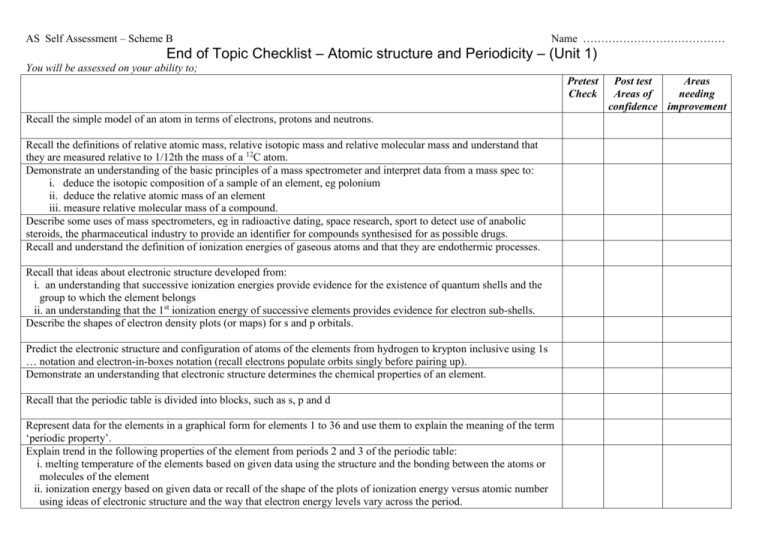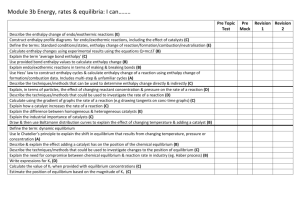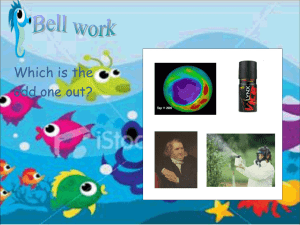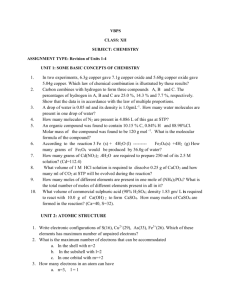End of Topic Checklist * Atomic structure
advertisement

AS Self Assessment – Scheme B
Name …………………………………
End of Topic Checklist – Atomic structure and Periodicity – (Unit 1)
You will be assessed on your ability to;
Pretest
Check
Recall the simple model of an atom in terms of electrons, protons and neutrons.
Recall the definitions of relative atomic mass, relative isotopic mass and relative molecular mass and understand that
they are measured relative to 1/12th the mass of a 12C atom.
Demonstrate an understanding of the basic principles of a mass spectrometer and interpret data from a mass spec to:
i. deduce the isotopic composition of a sample of an element, eg polonium
ii. deduce the relative atomic mass of an element
iii. measure relative molecular mass of a compound.
Describe some uses of mass spectrometers, eg in radioactive dating, space research, sport to detect use of anabolic
steroids, the pharmaceutical industry to provide an identifier for compounds synthesised for as possible drugs.
Recall and understand the definition of ionization energies of gaseous atoms and that they are endothermic processes.
Recall that ideas about electronic structure developed from:
i. an understanding that successive ionization energies provide evidence for the existence of quantum shells and the
group to which the element belongs
ii. an understanding that the 1st ionization energy of successive elements provides evidence for electron sub-shells.
Describe the shapes of electron density plots (or maps) for s and p orbitals.
Predict the electronic structure and configuration of atoms of the elements from hydrogen to krypton inclusive using 1s
… notation and electron-in-boxes notation (recall electrons populate orbits singly before pairing up).
Demonstrate an understanding that electronic structure determines the chemical properties of an element.
Recall that the periodic table is divided into blocks, such as s, p and d
Represent data for the elements in a graphical form for elements 1 to 36 and use them to explain the meaning of the term
‘periodic property’.
Explain trend in the following properties of the element from periods 2 and 3 of the periodic table:
i. melting temperature of the elements based on given data using the structure and the bonding between the atoms or
molecules of the element
ii. ionization energy based on given data or recall of the shape of the plots of ionization energy versus atomic number
using ideas of electronic structure and the way that electron energy levels vary across the period.
Post test
Areas
Areas of
needing
confidence improvement
AS Self Assessment – Scheme B
Name …………………………………
AS Self Assessment – Scheme B
Name …………………………………
End of Topic Checklist – Energetics – (Unit 1)
You will be assessed on your ability to;
Pretest
Check
Demonstrate an understanding of the term enthalpy change, H.
Construct simple enthalpy level diagrams showing the enthalpy change.
Recall the sign of H for exothermic and endothermic reactions, eg illustrated by the use of exo- and endothermic
reactions in hot and cold packs.
Recall the definition of standard enthalpy changes of reaction, formation, combustion, neutralization and atomization
and use experimental data to calculate energy transferred in a reaction and hence the enthalpy change of the reaction.
This will be limited to experiments where substances are mixed in an insulated container, and combustion experiments.
Recall Hess's Law and apply it to calculating enthalpy changes of reaction from data provided, selected from a table of
data or obtained from experiments and understand why standard data is necessary to carry out calculations of this type.
Evaluate the results obtained from experiments using the expression: energy transfer in joules = m x c x T
and comment on sources of error and assumptions made in the expts.
The following types of experiments should be known:
i experiments in which substances are mixed in an insulated container and the temp rise measured
ii simple enthalpy of combustion experiments using, eg a series of alcohols in a spirit burner
iii plan and carry out an experiment where the enthalpy change cannot be measured directly,
eg the enthalpy change for the decomposition of calcium carbonate using the enthalpy changes of reaction of
calcium carbonate and calcium oxide with hydrochloric acid
Demonstrate an understanding of the terms bond enthalpy and mean bond enthalpy, and use bond enthalpies HB in
Hess cycle calculations and recognise their limitations. Understand that bond enthalpy data gives some indication
about which bond will break first in a reaction, how easy or difficult it is and therefore how rapidly a reaction will
take place at room temperature.
Post test
Areas of
confidence
Areas
needing
improvement
AS Self Assessment – Scheme B
Name …………………………………
End of Topic Checklist – Introduction to Organic Chemistry – (Unit 1)
You will be assessed on your ability to;
Pretest
Check
Demonstrate an understanding that there are series of organic compounds characterised by a general formula and one or
more functional groups.
Apply the rules of IUPAC nomenclature to compounds relevant to this specification and draw these compounds, as they
are encountered in the specification, using structural, displayed and skeletal formulae.
Appreciate the difference between hazard and risk.
Demonstrate an understanding of the hazards associated with organic compounds and why it is necessary to carry out
risk assessments when dealing with potentially hazardous materials. Suggest ways by which risks can be reduced and
reactions can be carried out safely by:
i. working on a smaller scale
ii. taking specific precautions or using alternative techniques depending on the properties of the substances involved
iii. carrying out the reaction using an alternative method that involves less hazardous substances.
End of Topic Checklist – Organic Chemistry - Alkanes – (Unit 1)
State the general formula of alkanes and understand that they are saturated hydrocarbons which contain single bonds
only.
Explain the existence of structural isomers using alkanes (up to C5) as examples.
Know that alkanes are used as fuels and obtained from the fractional distillation, cracking and reformation of crude oil.
Discuss the reasons for developing alternative fuels in terms of sustainability and reducing emissions, including the
emission of CO2 and its relationship to climate change.
Describe the reactions of alkanes in terms of combustion and substitution by chlorine showing the mechanism of free
radical substitution in terms of initiation, propagation and termination, and using curly half-arrows in the mechanism to
show the formation of free radicals in the initiation step using a single dot to represent the unpaired electron.
Give definition of the term free radical.
Demonstrate an understanding of the concept of a reaction mechanism and that bond breaking can be homolytic or
heterolytic and that the resulting species are either free radicals, electrophiles or nucleophiles.
Post test
Areas of
confidence
Areas
needing
improvement
AS Self Assessment – Scheme B
Name …………………………………
AS Self Assessment – Scheme B
Name …………………………………
End of Topic Checklist – Organic Chemistry - Alkenes – (Unit 1)
State the general formula of alkenes and understand that they are unsaturated hydrocarbons with a carbon-carbon double
bond which consists of a and a bond.
Explain E-Z isomerism (geometric/cis-trans isomerism) in terms of restricted rotation around a C=C double bond and
the nature of the substituents on the carbon atoms.
Demonstrate an understanding the E-Z naming system and why it is necessary to use this when the cis- and transnaming system breaks down.
Describe the addition reactions of alkenes, limited to;
i.
the addition of hydrogen with a nickel catalyst to form an alkane
ii.
the addition of halogens to produce di-substituted halogenoalkanes
iii.
the addition of hydrogen halides to produce mono-substituted halogenoalkanes
iv.
oxidation of the double bond by potassium manganate(VII) to produce a diol.
Describe the mechanism (including diagrams), giving evidence where possible, of:
i.
the electrophilic addition of bromine and hydrogen bromide to ethene
ii.
the electrophilic addition of hydrogen bromide to propene.
Describe the test for the presence of C=C using bromine water and understand that the product is the addition of OH and
Br.
Describe addition polymerization of alkenes - identify the repeat unit given the monomer, and vice versa.
Interpret given information about the uses of energy and resources over the life cycle of polymer products to show how
the use of renewable resources, recycling and energy recovery can contribute to the more sustainable use of materials.
Give definition of the term electrophile.
AS Self Assessment – Scheme B
Name …………………………………
End of Topic Checklist – Organic Chemistry - Halogenoalkanes – (Unit 2)
You will be assessed on your ability to;
Pretest
Check
Demonstrate an understanding of the nomenclature and corresponding structural, displayed and skeletal formulae for
halogenoalkanes, including the distinction between primary, secondary and tertiary structures.
Interpret given data and observations comparing the reactions and reactivity of primary, secondary and tertiary
compounds.
Carry out the preparation of an halogenoalkane from an alcohol and explain why a metal halide and concentrated
sulfuric acid should not be used when making a bromoalkane or an iodoalkane.
Describe the typical behaviour of halogenoalkanes. This will be limited to treatment with:
i.
aqueous alkali, eg KOH (aq)
ii.
alcoholic potassium hydroxide
iii.
water containing dissolved silver nitrate
iv.
alcoholic ammonia.
Discuss the uses of halogenoalkanes, eg as fire retardants and modern refrigerants.
Give definition of the term nucleophile.
Demonstrate an understanding of the link between bond polarity and the type of reaction mechanism a compound will
undergo.
Describe the mechanisms of the substitution reactions of halogenoalkanes.
Post test
Areas of
confidence
Areas
needing
improvement
AS Self Assessment – Scheme B
Name …………………………………
End of Topic Checklist – Organic Chemistry - Alcohols – (Unit 2)
You will be assessed on your ability to;
Pretest
Check
Post test
Areas of
confidence
Areas
needing
improvement
Give examples of, and recognise, molecules that contain the alcohol functional group.
Demonstrate an understanding of the nomenclature and corresponding structural, displayed and skeletal formulae of
alcohols, and classify them as primary, secondary or tertiary.
Describe the following chemistry of alcohols:
i.
combustion
ii.
reaction with sodium
iii.
substitution reactions to form halogenoalkanes, including reaction with PCl5 and its use as a qualitative
test for the presence of the -OH group.
iv.
oxidation using potassium dichromate(VI) in dilute sulfuric acid on primary alcohols to produce
aldehydes and carboxylic acids and on secondary alcohols to produce ketones.
Demonstrate an understanding of, and practise, the preparation of an organic liquid (reflux and distillation), eg oxidation
of alcohols.
End of Topic Checklist – Organic Chemistry – Mass Spectra and IR – (Unit 2)
You will be assessed on your ability to;
Pretest
Check
Interpret fragment ion peaks in the mass spectra of simple organic compounds,
eg the difference between propanal and propanone.
Use infrared spectra, or data from infrared spectra, to deduce functional groups present in organic compounds and
predict infrared absorptions, given wavenumber data, due to familiar functional groups.
This will be limited to:
i. C-H stretching absorptions in alkanes, alkenes and aldehydes
ii. O-H stretching absorption in alcohols and carboxylic acids
iii. N-H stretching absorption in amines
iv. C=O stretching absorption in aldehydes and ketones
v. C-X stretching absorption in halogenoalkanes
vi. as an analytical tool to show the change in functional groups during the oxidation of an alcohol to a C=O.
Post test
Areas of
confidence
Areas
needing
improvement
AS Self Assessment – Scheme B
Demonstrate an understanding that only molecules which change their polarity as they vibrate can absorb infrared
radiation.
Demonstrate an understanding that H2O, CO2, CH4 and NO molecules absorb IR radiation and are greenhouse gases,
whilst O2 and N2 are not.
Name …………………………………
AS Self Assessment – Scheme B
Name …………………………………
End of Topic Checklist – Green Chemistry – (Unit 2)
You will be assessed on your ability to;
Pretest
Check
Demonstrate an understanding that the processes in the chemical industry are being reinvented to make them more
sustainable ('greener') by:
i.
changing to renewable resources
ii.
finding alternatives to very hazardous chemicals
iii.
discovering catalysts for reactions with higher atom economies, eg the development of methods used to
produce ethanoic acid based on catalysts of cobalt, rhodium and iridium
iv.
making more efficient use of energy, eg the use of microwave energy to heat reactions in the
pharmaceutical industry
v.
reducing waste and preventing pollution of the environment.
Use chemical equations deduce atom economies in laboratory and industrial processes and understand why they are
important.
Discuss the relative effects of different greenhouse gases as absorbers of IR and hence on global warming.
Discuss the difference between anthropogenic and natural climate change over hundreds of thousands of years.
Demonstrate understanding of the terms 'carbon neutrality' and 'carbon footprint'.
Apply the concept of carbon neutrality to different fuels, such as petrol, bio-ethanol and hydrogen.
Discuss and explain, including the mechanisms for the reactions, the science community's reasons for recommending
that CFC’s are no longer used due to their damaging effect on the ozone layer.
Demonstrate an understanding of how oxygen, O2, and ozone, O3, absorb UV radiation and explain the part played by
emission of oxides of nitrogen, from aircraft, in the depletion of the ozone layer, including the free radical mechanism
for the reaction and the fact that oxides act as catalysts.
Post test
Areas of
confidence
Areas
needing
improvement
AS Self Assessment – Scheme B
Name …………………………………
End of Topic Checklist – Chemical Equilibria – (Unit 1)
You will be assessed on your ability to;
Pretest
Check
Demonstrate an understanding that chemical equilibria are dynamic.
Deduce the qualitative effects of changes of temperature, pressure and concentration on the position of equilibrium,
eg extraction of methane from methane hydrate.
Interpret the results of simple experiments to demonstrate the effect of a change of temperature, pressure and
concentration on a system at equilibrium,
eg iodine(I) chloride reacting with chlorine to form iodine(III) chloride,
or N2O4
2NO2
End of Topic Checklist – Chemical Equilibria – (Unit 4)
Demonstrate an understanding of the term 'dynamic equilibrium' as applied to states of matter, solutions and chemical
reactions.
Recall that many important industrial reactions are reversible.
Use practical data to establish the idea that a relationship exists between the equilibrium concentrations of reactants and
products which produces the equilibrium constant for a particular reaction, eg data on the hydrogen-iodine equilibrium.
Calculate a value for the equilibrium constant for a reaction based on data from experiment,
eg the reaction of ethanol and ethanoic acid.
the equilibrium Fe2+(aq) + Ag+ (aq)
Fe3+(aq) + Ag(s)
or the distribution of ammonia or iodine between two immiscible solvents.
Construct expressions for Kc and Kp for homogeneous and heterogeneous systems, in terms of equilibrium
concentrations or equilibrium partial pressures, perform simple calculations on Kc and Kp and work out the units of the
equilibrium constants.
Apply knowledge of the value of equilibrium constants to predict the extent to which a reaction takes place.
Post test
Areas of
confidence
Areas
needing
improvement







